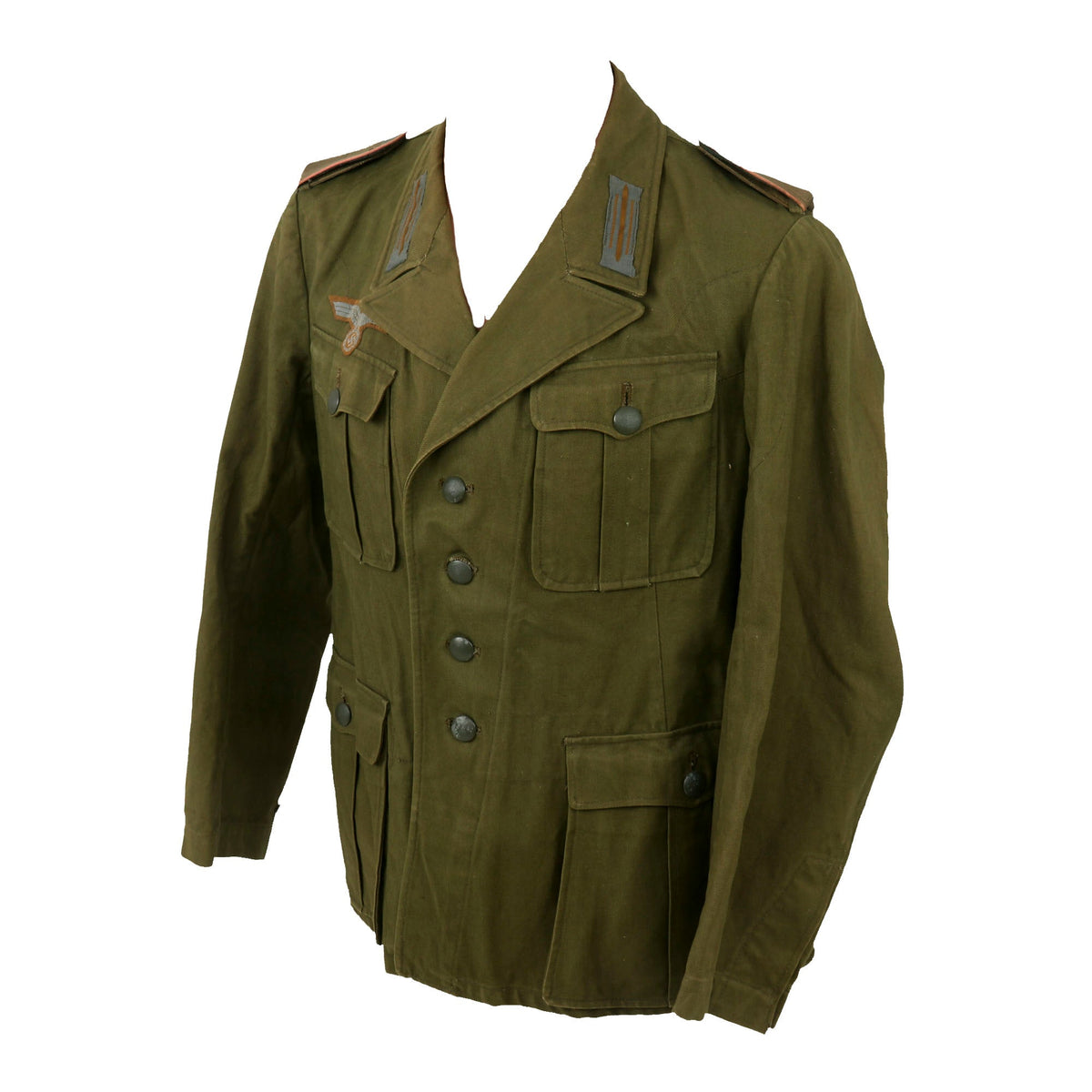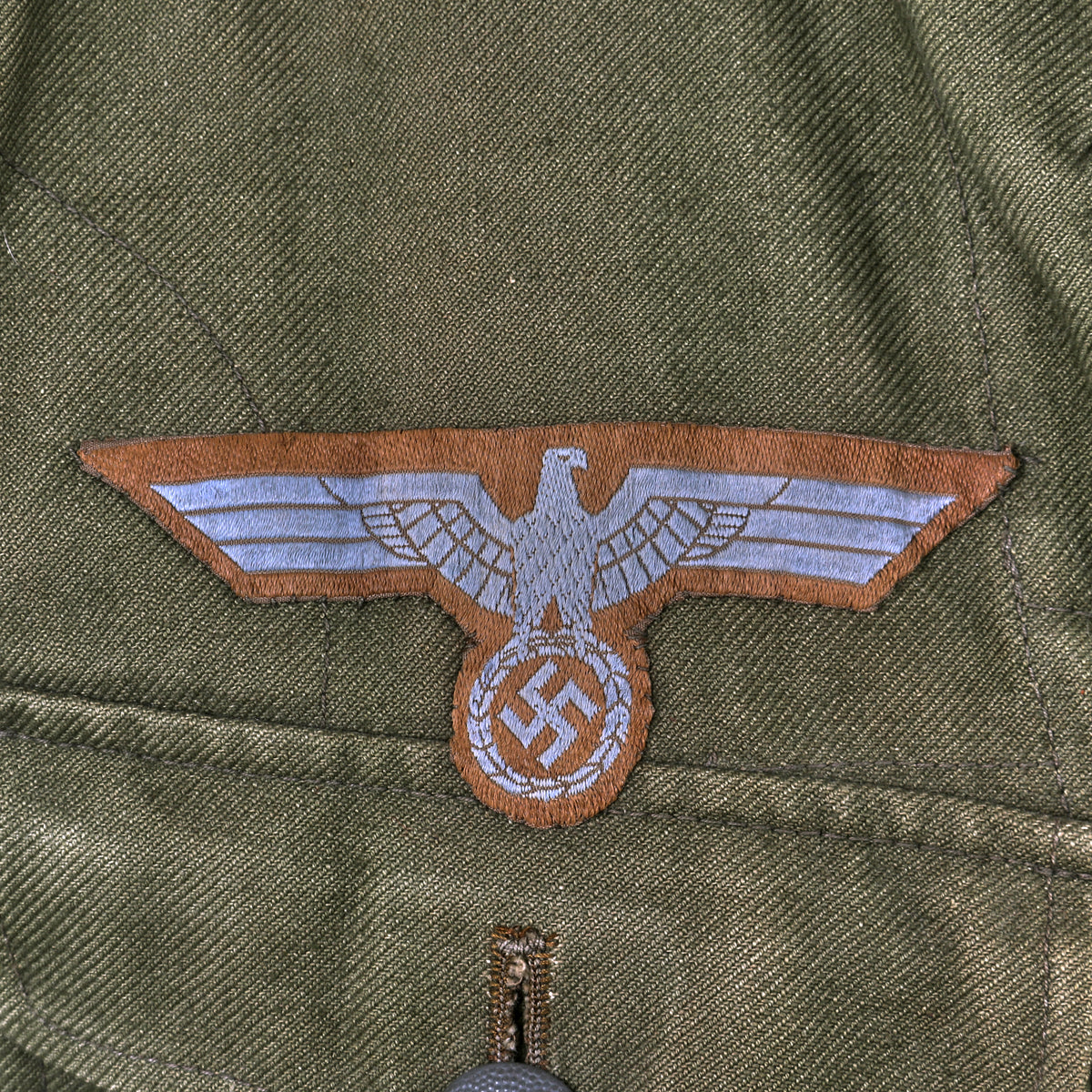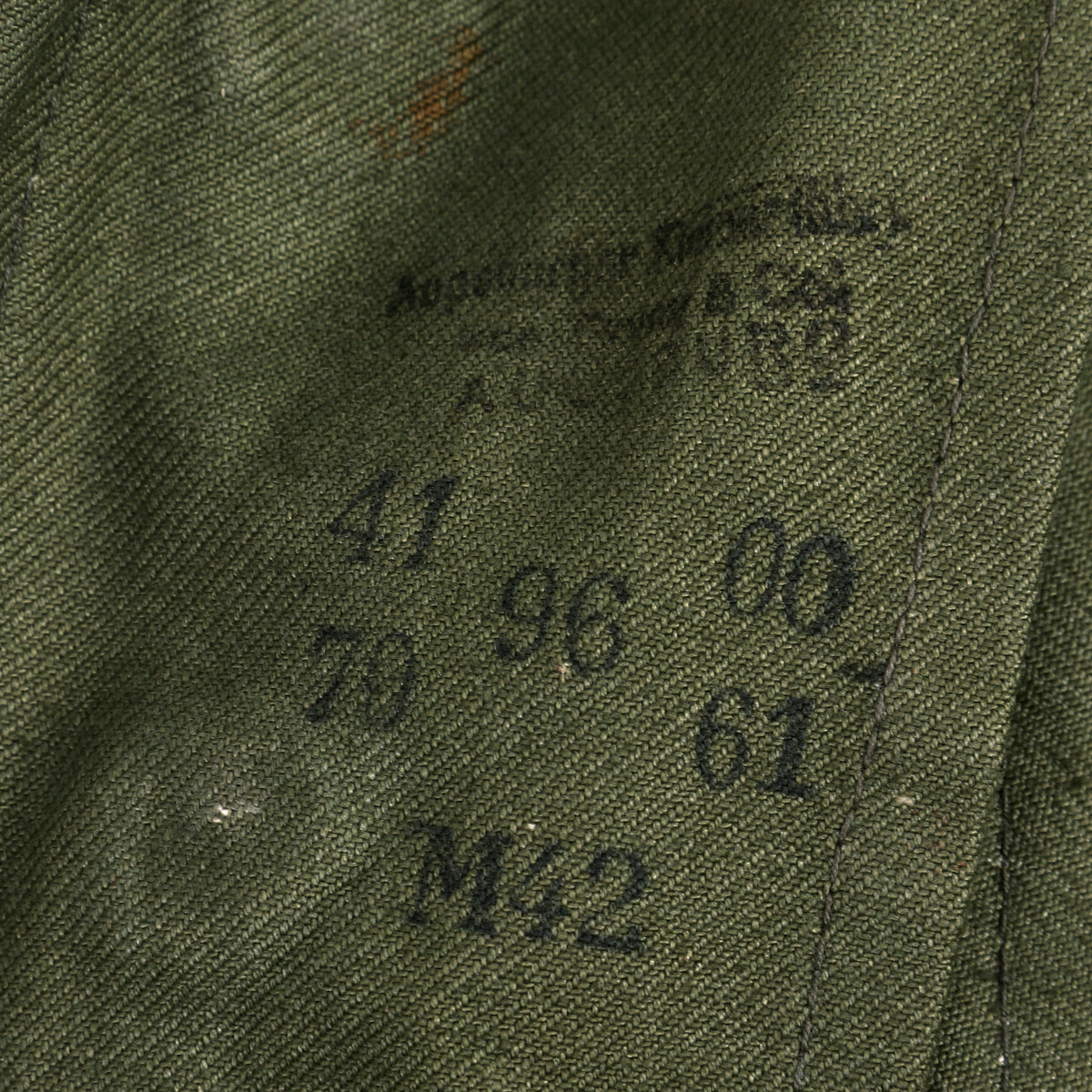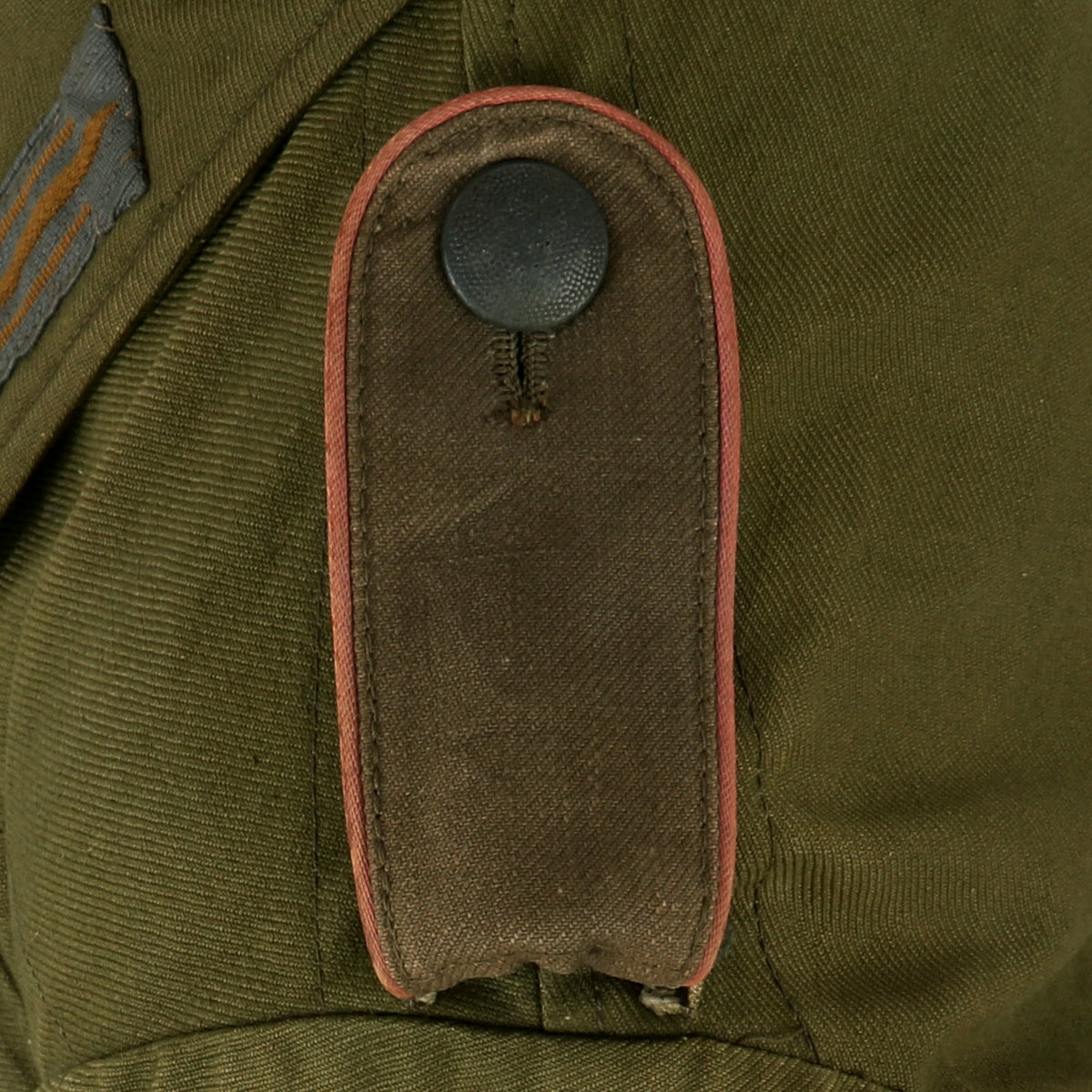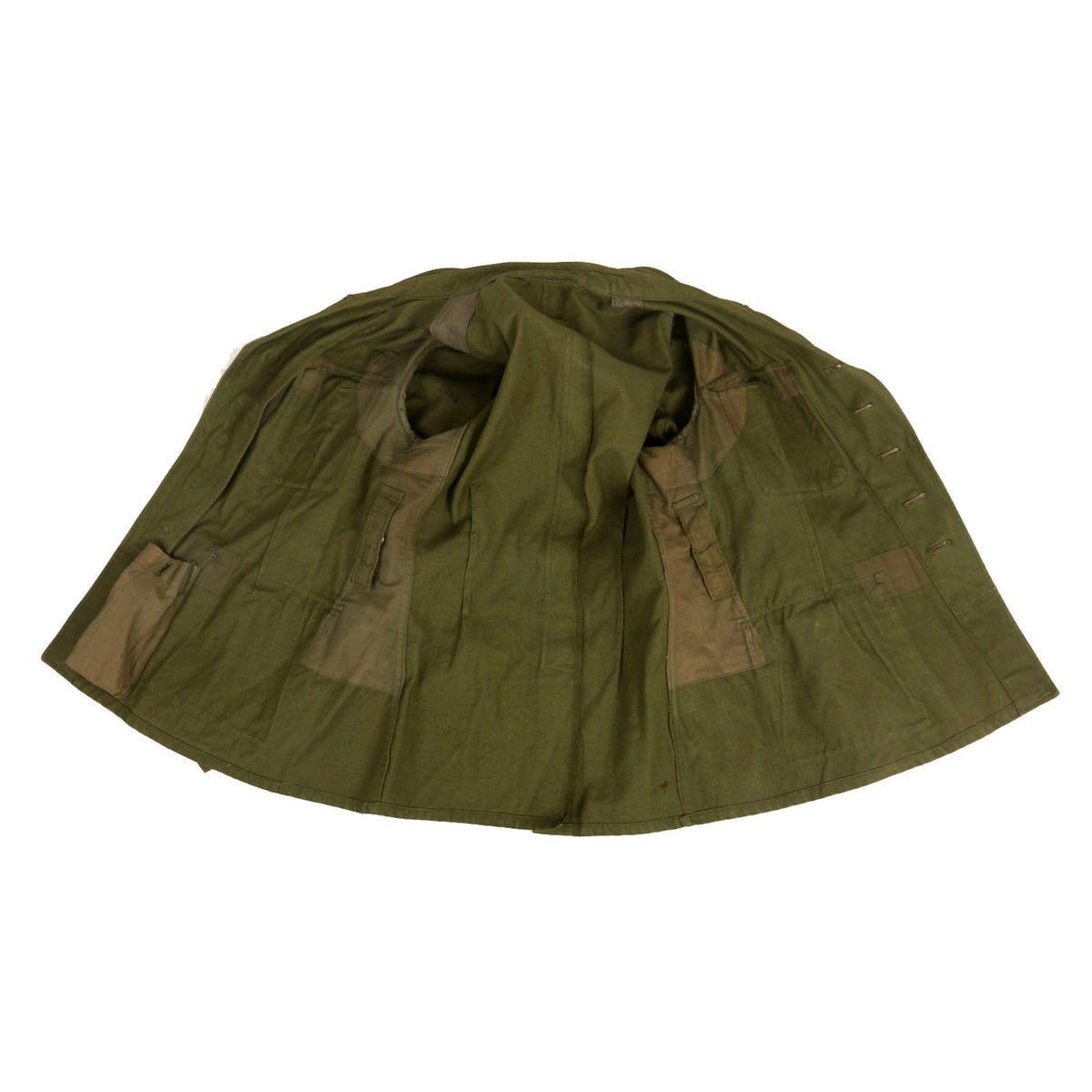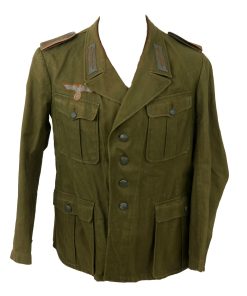Original Excellent German WWII Afrika Korps Panzer Tank Enlisted First Pattern Tropical Tunic with Maker Markings – Dated 1942 Original Items
$ 3.195,00 $ 798,75
Original Item: One-of-a-kind. In early 1941, the German military began their conquest of southern Europe. Due to the warmer climates of these areas, the German Army needed to equip its troops with a more suitable form of dress, and replace the standard wool based feldgrau uniforms. The new “tropical” uniforms were lighter in weight, and dyed in colors ranging from light tan to dark olive.
This 100% authentic German World War Two First Pattern Heer Tropical Tunic is in excellent condition, showing very little evidence that it saw use in service. We have seen this version called the M40 or the M41 Tropenbluse (tropical blouse), and it is the type closest in configuration to the original M36/M40 style. The front of the tunic has four pleated pockets (later examples were flat), and it has the early pattern scalloped pocket flaps on the breast pockets. The tunic is made out of a lightweight canvas denim-like twill material, which has been dyed a darker olive/tan. The tunic features a machine applied BeVo tropical Heer Breast eagle, with the correct blue threads on an olive background, which is textbook.
This very nice uniform has the correct EM litzen on each side of the collar opening, which BeVo embroidered gray blue with dunkelgelb (dark yellow) olive tan strips, each neatly machine stitched to the collar. The button attached style Enlisted Schulterklappen (shoulder straps) have tan tops with a feldgrau wool underlayer, and tan straps. They are piped around the edge with Rosa (Rose-pink), which was the Waffenfarbe (corps color) during WWII for the Panzers (Armored Troops) and Panzerjäger (Tank Destroyers). They do not have any rank “pips” installed, so these would indicate the lowest enlisted rank of Panzerschütze (Armor Rifleman), equivalent to a Soldat or U.S. Army Private.
The front of the tunic has five original buttons for the main closure, and four pocket buttons, all of which were originally a nice green color. The buttons on this tunic are retained by round circlips from the rear, and all are non-magnetic, probably made from zinc. We did not see any maker markings on the reverse, and the paint has flaked away somewhat from the buttons, which is very common due to the zinc material. As is correct for this type of tunic, it is unlined except for specific areas, such as the sides, which have canvas reinforcement. It has the usual bandage pocket on the lower right interior, and in this case, there is an original 1940 dated bandage still in the wrapper inside.
The button flap on the right side bears a maker marking, which is not quite clear, but we can make out the first word as Augsburger, and the bottom line reads AUGSBURG, so we are fairly certain the company who made it was located in Augsburg, located outside of Munich in Bavaria. Under this is the complete size information, complete with a depot marking and date:
41 00
96
70 61
M42.
This would indicate that the uniform was processed through the Munich (München) depot in 1942. Some research may be able to identify the full name of the maker.
Overall condition is just great, with just a few stitch pulls and weave errors in the fabric. This is really an example that would be impossible to improve upon. The shoulder straps show a bit of wear, and were probably worn on another uniform prior to this tunic.
A fantastic totally genuine Afrika Korps First Pattern tunic in nearly unissued condition. It is unlikely that we will see a better example of one of these early tunics any time in the near future! Ready to display!
Approximate Measurements:
Collar to shoulder: 9″
Shoulder to sleeve: 24.5”
Shoulder to shoulder: 15”
Chest width: 18″
Waist width: 18″
Hip width: 22″
Front length: 28.5″
Terms such as M40 and M43 were never designated by the Wehrmacht, but are names given to the different versions of the Model 1936 field tunic by modern collectors, to discern between variations, as the M36 was steadily simplified and tweaked due to production time problems and combat experience.
Field Tunic (Feldbluse) Model 1936
When the NSDAP came to power in early 1933 the Reichswehr, the armed forces of the Weimar Republic, were near the end of a two-year project to redesign the Army Feldbluse (field-blouse). Beginning in that year the new tunic was issued to the Reichsheer and then the rapidly growing Wehrmacht Heer, although minor design changes continued to be made until the appearance of the standardized Heeres Dienstanzug Modell 1936. The M36 tunic still retained the traditional Imperial and Reichswehr uniform color of grey-green “field gray” (feldgrau) wool, but incorporated four front patch pockets with scalloped flaps and pleats (on Reichswehr tunics the lower pockets were internal and angled). The front was closed with five buttons rather than the previous eight, and the collar and shoulder straps were of a dark bottle-green instead of the Reichswehr grey. Compared to the Weimar-era uniforms the skirt of the feldbluse was shorter and the tailoring was more form-fitting due to Germany’s adoption of mechanized warfare: soldiers now spent much time in the confined space of a vehicle and a shorter jacket was less likely to pick up dirt from the seats. It also included an internal suspension system, whereby a soldier could hang an equipment belt on a series of hooks outside of the tunic. These hooks were connected to two straps inside the lining, which spread the weight of equipment without having to use external equipment suspenders. The M36 was produced and issued until the very end of the war, though successive patterns became predominant.
SS field uniforms were of similar appearance externally but to fit their larger patches had a wider, feldgrau collar, and the lower pockets were of an angled slash type similar to the black or grey SS service-dress. The second button of an SS Feldbluse was positioned somewhat lower, so that it could be worn open-collar with a necktie. Due to supply problems the SS were often issued army uniforms.
History of the German Africa Korps
The Afrika Korps or German Africa Corps (Deutsches Afrikakorps or DAK) was the German expeditionary force in Africa during the North African Campaign of World War II. First sent as a holding force to shore up the Italian defense of their African colonies, the formation fought on in Africa, under various appellations, from March 1941 until its surrender in May 1943. The term “Afrika Korps” is pseudo-German (so-called “cod-German”), deriving from an incomplete German title. The German term referred solely to the initial formation, the Deutsches Afrikakorps (DAK), which formed part of the Axis command of the German and Italian forces in North Africa. The name stuck, with both news media and Allied soldiers, as the name for all subsequent German units in North Africa. The unit is known for having been commanded by Field Marshal Erwin Rommel.
The dry climate of Africa proved to be an issue with much of the standard leather field gear that the German Army usually used. It would dry out and crack quickly, and become unusable. To deal with this, the standard field gear such as belts, Y-straps, A-frames, bayonet frogs, and other items, were issued in special tropical web versions.
Fast Shipping with Professional Packaging
Thanks to our longstanding association with UPS FedEx DHL, and other major international carriers, we are able to provide a range of shipping options. Our warehouse staff is expertly trained and will wrap your products according to our exact and precise specifications. Prior to shipping, your goods will be thoroughly examined and securely secured. We ship to thousands clients each day across multiple countries. This shows how we're dedicated to be the largest retailer on the internet. Warehouses and distribution centres can be located throughout Europe as well as the USA.
Note: Orders with more than one item will be assigned a processing date depending on the item.
Before shipping before shipping, we'll conduct a thorough inspection of the items you have ordered. Today, the majority of orders will be delivered within 48 hours. The delivery time will be between 3-7 days.
Returns
The stock is dynamic and we cannot completely manage it because multiple stakeholders are involved, including our factory and warehouse. So the actual stock may alter at any time. It's possible that you may not receive your order once the order has been made.
Our policy is valid for a period of 30 days. If you don't receive the product within 30 days, we are not able to issue a refund or an exchange.
You can only return an item if it is unused and in the same state as the day you received it. You must have the item in its original packaging.
Related products
Uncategorized
Uncategorized
Uncategorized
Uncategorized
Uncategorized
Uncategorized
Uncategorized
Uncategorized
Uncategorized
Angolan Rebel 1970s era 60mm Inert Display Mortar from Angolan Civil War Original Items
Uncategorized
Band of Brothers ORIGINAL GERMAN WWII Le. F.H. 18 10.5cm ARTILLERY PIECE Original Items
Uncategorized
Uncategorized
Armoured Fighting Vehicles of the World: AFVs of World War One (Hardcover Book) New Made Items
Uncategorized
Uncategorized
Uncategorized
Uncategorized
Uncategorized
Armored Burgonet Helmet & Polearm from Scottish Castle Leith Hall Circa 1700 Original Items
Uncategorized
Uncategorized

